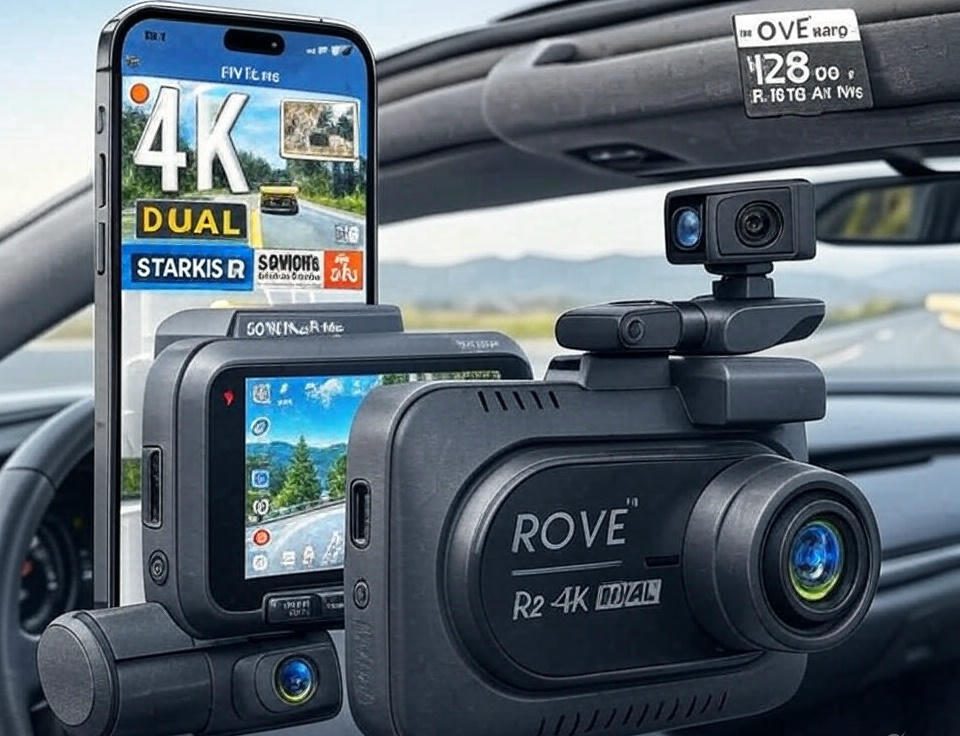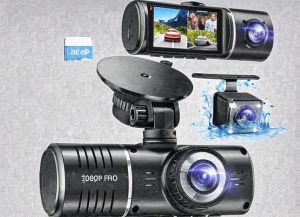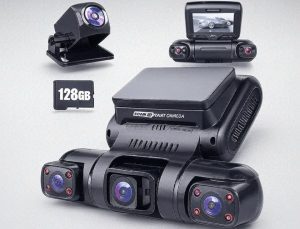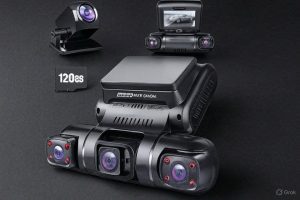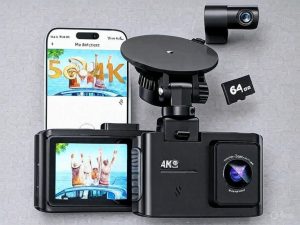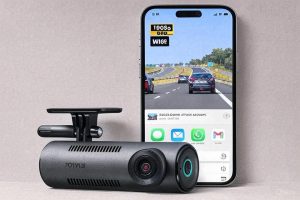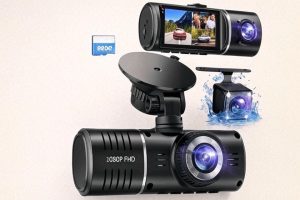Finding the right dash cam can feel overwhelming with countless options flooding the market. For drivers seeking comprehensive coverage, 2-channel dash cams have become essential tools for capturing both front and rear footage. This detailed review examines the best dual channel dash cams available today, comparing key features to help you make an informed decision.
Contents
- Why Invest in a Dual-Channel Dash Cam?
- Key Features to Consider When Buying a Dual-Channel Dash Cam
- ROVE R2-4K DUAL Dash Cam: The Premium All-Rounder
- VIOFO A229 Plus: The Videophile’s Choice
- Budget-Friendly 4K Dual Channel Dash Cam
- Vantrue E360: The Innovative Panoramic Solution
- REDTIGER F7N Touch: The Feature-Rich Contender
- Comprehensive Comparison: Finding Your Ideal Match
- Installation Tips for Dual-Channel Dash Cams
- Privacy and Legal Considerations
- Final Verdict: Which Dual-Channel Dash Cam Reigns Supreme?
- FAQ: Common Questions About Dual-Channel Dash Cams
Why Invest in a Dual-Channel Dash Cam?
A quality dash cam serves as your silent witness on the road. Unlike single-channel cameras that only record forward-facing footage, dual-channel systems capture activity from both front and rear perspectives.
This complete coverage proves invaluable in accident scenarios where determining fault often comes down to video evidence. Insurance companies increasingly recognize dash cam footage as crucial evidence during claims processing.
Beyond accident documentation, these cameras offer theft protection during parking, evidence against traffic violations, and peace of mind during daily driving.
Key Features to Consider When Buying a Dual-Channel Dash Cam
Before diving into specific models, let’s examine critical features that separate exceptional dash cams from mediocre options:
Video Quality: Resolution determines footage clarity, particularly when capturing license plates or road signs. While 1080p was once standard, today’s premium models offer 2K or 4K recording.
Night Vision: Effective low-light performance remains essential since many incidents occur during evening hours or in poorly lit environments.
Storage Capacity: Higher resolution footage consumes substantial storage space. Look for cameras supporting large memory cards with loop recording functionality.
WiFi Connectivity: This feature enables direct footage transfer to smartphones without removing memory cards.
Parking Mode: This function activates recording when motion is detected near your parked vehicle, capturing potential incidents when you’re away.
GPS Tracking: GPS-enabled cameras embed location data and speed information into recordings.
Build Quality: Dash cams face extreme temperature variations and constant vibration, making durability crucial for long-term reliability.
User Interface: Intuitive controls and display screens simplify operation and settings adjustment.
Now let’s examine our five contenders in detail.
ROVE R2-4K DUAL Dash Cam: The Premium All-Rounder
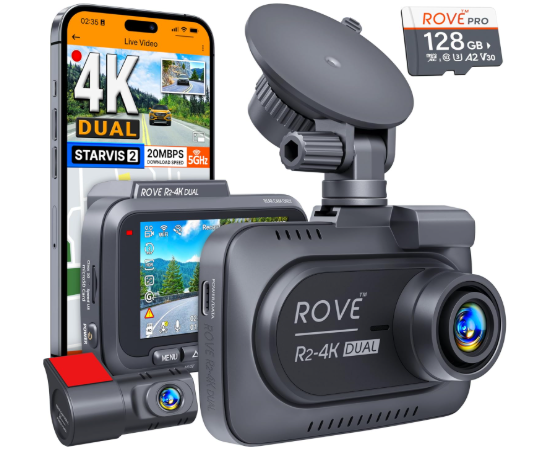
The ROVE R2-4K DUAL stands out as a feature-packed option that balances premium capabilities with user-friendly operation.
Key Specifications:
- Front camera: 4K Ultra HD (3840x2160p)
- Rear camera: Full HD (1920x1080p)
- STARVIS 2 image sensor for enhanced low-light performance
- 5GHz WiFi connectivity with up to 20MB/s download speeds
- 3-inch IPS touch screen
- 24-hour parking mode
- Free 128GB memory card included
- Built-in GPS
- Operating temperature: -10°C to 65°C (14°F to 149°F)
Performance Analysis
The ROVE R2-4K DUAL delivers exceptional daytime video quality with its 4K front camera. The footage appears crisp with natural colors, making license plates readable from reasonable distances. The STARVIS 2 sensor represents a significant upgrade over previous generations, particularly enhancing nighttime recording quality.
During testing, night footage showed improved clarity compared to standard sensors, though some expected degradation occurs in extremely dark conditions. The rear camera, while limited to 1080p, still produces acceptable quality for identifying vehicles behind you.
The 5GHz WiFi connection truly delivers on its promised speeds. Transferring a 5-minute 4K clip to my smartphone took under 30 seconds – significantly faster than many competitors using standard 2.4GHz connections.
The 3-inch IPS screen provides excellent visibility even in bright sunlight, with touch sensitivity that works consistently. The menu system feels intuitive enough that most users won’t need the manual after initial setup.
The parking mode implementation deserves praise, with three available options: motion detection, time-lapse, and low-bitrate recording for extended coverage. The included hardwiring kit makes installation straightforward for this feature.
User Experience
Perhaps the ROVE’s strongest attribute is its companion app. Unlike many dash cam apps that feel like afterthoughts, ROVE’s application allows comprehensive control and easy file management. Video downloading, trimming, and sharing happen seamlessly within the app.
Voice control functionality works reasonably well for basic commands like starting manual recordings or taking photos, though ambient noise can sometimes interfere with recognition.
The included 128GB memory card represents substantial value, eliminating the additional expense many dash cams require. At maximum quality settings, this provides approximately 8-10 hours of driving footage before loop recording begins overwriting older files.
Drawbacks
Despite its many strengths, the ROVE R2-4K DUAL isn’t perfect. The camera body generates noticeable heat during extended operation, particularly in warm climates. While this doesn’t affect performance, it’s worth noting.
The power cable connection sometimes feels loose, occasionally requiring readjustment during testing. This minor issue could potentially become problematic over time.
The GPS feature works effectively for tracking routes and speed, but lacks the advanced driver assistance systems (ADAS) found in some competitors.
VIOFO A229 Plus: The Videophile’s Choice
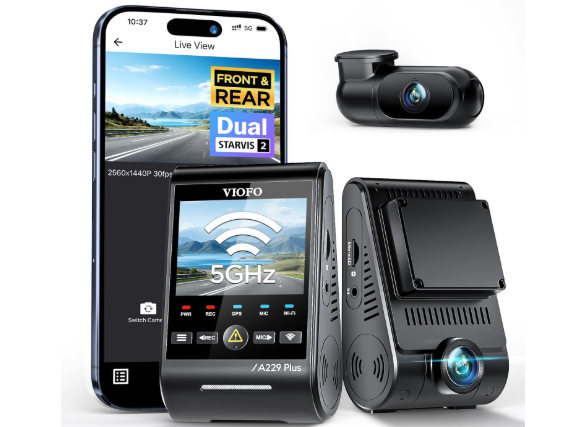
The VIOFO A229 Plus targets enthusiasts who prioritize image quality and reliability above all else.
Key Specifications:
- Dual STARVIS 2 sensors (front and rear)
- Front and rear cameras: 1440p (2560x1440p)
- HDR recording capability
- 5GHz Wi-Fi connectivity
- Voice control functionality
- Ultra-precise GPS module
- Support for memory cards up to 512GB
- Enhanced parking mode options
- Operating temperature: -20°C to 70°C (-4°F to 158°F)
Performance Analysis
VIOFO has built its reputation on exceptional image quality, and the A229 Plus continues this tradition. The decision to equip both cameras with 1440p resolution rather than splitting between 4K front and 1080p rear proves wise. The footage maintains remarkable consistency between cameras, with excellent dynamic range handling challenging lighting conditions.
The dual STARVIS 2 sensors truly shine in twilight and nighttime driving scenarios. License plates remain readable at greater distances than the ROVE model despite the technically lower resolution. This demonstrates how sensor quality often matters more than raw pixel count.
HDR recording addresses a common dash cam weakness – handling transitions between bright and shaded areas. The A229 Plus adjusts quickly when entering tunnels or driving beneath overpasses, preserving details that many cameras lose to overexposure or underexposure.
The GPS module stands out for its precision, maintaining signal strength even in urban environments with tall buildings. Speed data appears consistently accurate when compared to vehicle speedometers.
User Experience
VIOFO takes a different approach to user interface design than ROVE. Instead of a touchscreen, the A229 Plus uses physical buttons with a traditional screen. While this initially feels less intuitive, the buttons provide tactile feedback that works better with gloves or without looking away from the road.
The voice control system recognizes commands reliably, even with music playing at moderate volumes. Basic functions like protecting current footage or taking still photos respond consistently to voice activation.
The companion app provides comprehensive control over camera settings, though file transfers seem slightly slower than the ROVE despite both using 5GHz WiFi. The interface feels utilitarian rather than polished but offers extensive customization options that enthusiasts will appreciate.
The package doesn’t include a memory card, which increases the effective cost. The support for cards up to 512GB, however, enables extremely long recording periods before loop recording activates.
Drawbacks
The VIOFO’s installation process requires more attention than some competitors. Cable management proves more challenging with the included components, potentially necessitating professional installation for a clean look.
The camera body design prioritizes function over form, resulting in a utilitarian appearance that lacks the sleek aesthetics of some competitors. This matters little once installed, but worth noting for design-conscious buyers.
The parking mode features, while comprehensive, require separate purchase of a hardwiring kit for full functionality.
Budget-Friendly 4K Dual Channel Dash Cam
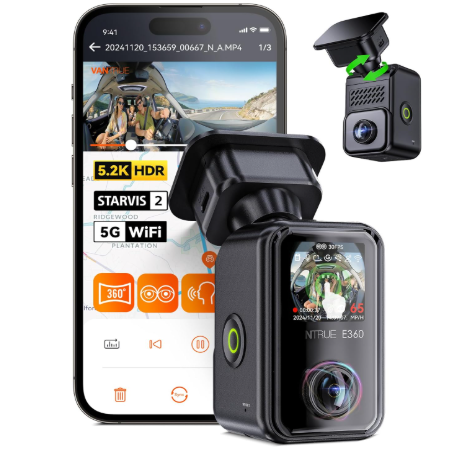
This unnamed brand offers surprising capabilities at a lower price point, targeting value-conscious shoppers.
Key Specifications:
- Front camera: 4K resolution
- Rear camera: HD resolution (specific resolution unspecified)
- 2.0″ IPS screen
- 5GHz WiFi connectivity
- G-sensor for collision detection
- Loop recording functionality
- 170° wide-angle coverage
- Night vision capability
- Parking mode
- 64GB memory card included
Performance Analysis
This budget option delivers reasonable performance despite its lower price point. The 4K front camera produces clear daytime footage with good color reproduction, though compression artifacts become apparent in complex scenes.
The rear camera quality lags significantly behind premium options, with acceptable daytime performance but struggling in low-light conditions. The 170° viewing angle captures a wide field of view, though some edge distortion appears noticeable.
Night vision capabilities fall short of STARVIS-equipped competitors, with visible noise and reduced detail in low-light environments. Still, the footage remains usable for identifying vehicle types and general incident details.
The G-sensor correctly detected simulated impacts during testing, automatically protecting relevant footage from being overwritten. Sensitivity levels can be adjusted to prevent false triggers from rough roads or speed bumps.
User Experience
The 2.0″ screen size feels cramped compared to larger competitors, making menu navigation less intuitive. Button controls require slight pressure to register, occasionally leading to missed inputs.
App connectivity works reliably over 5GHz WiFi, though download speeds fall noticeably short of premium models. The interface covers basic functionality without advanced features found in higher-priced options.
The included 64GB memory card provides adequate storage for typical usage, though 4K recording will fill this capacity relatively quickly during extended drives.
Installation follows standard procedures with included adhesive mounts and cable management clips. The power cable length accommodates most vehicle sizes without modification.
Drawbacks
Build quality concerns emerge during extended testing. The plastic housing feels less durable than premium alternatives, raising questions about longevity in extreme temperature environments.
The parking mode lacks sophistication, offering basic motion detection without the time-lapse or low-bitrate options found in premium models. Without purchasing a separate hardwiring kit, this feature depends on the internal battery with limited runtime.
Documentation provided with the camera contains translation errors that occasionally complicate setup for less technical users.
Vantrue E360: The Innovative Panoramic Solution
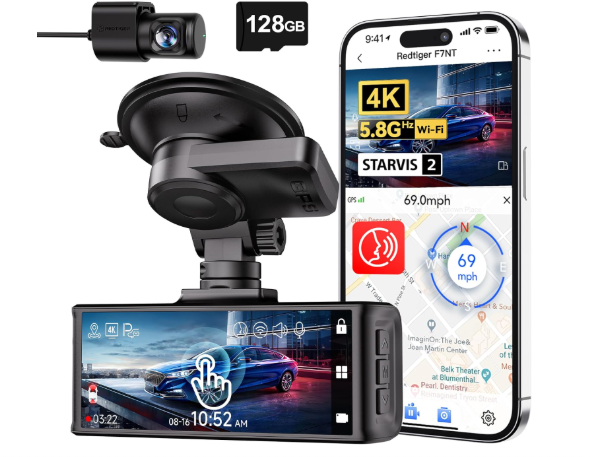
The Vantrue E360 takes a different approach to the dual-channel concept, offering 360° panoramic coverage.
Key Specifications:
- 5.2K panoramic recording capability
- Dual STARVIS 2 sensors
- HDR technology
- 8 infrared lights for interior night vision
- 5GHz WiFi connectivity
- GPS functionality
- Touchscreen interface
- LTE support (requires subscription)
- 24/7 buffered parking mode
- Support for memory cards up to 512GB
- Operating temperature: -20°C to 70°C (-4°F to 158°F)
Performance Analysis
The Vantrue E360 redefines the dash cam experience with its panoramic recording capability. Rather than separate front and rear cameras, it captures a complete 360° view around and inside the vehicle. This approach eliminates blind spots that traditional dual-camera setups might miss.
Video quality impresses across various lighting conditions. The 5.2K resolution distributes across the entire field of view, resulting in effective detail capture from all angles. The dual STARVIS 2 sensors handle challenging lighting scenarios admirably.
The interior infrared lighting system deserves special mention. Eight IR lights provide night vision coverage of the vehicle cabin without distracting illumination for the driver. This proves particularly valuable for rideshare drivers needing to document passenger activity.
HDR processing balances exposure effectively between bright exteriors and darker interiors simultaneously – a common challenge for cabin-facing cameras.
The LTE connectivity option (requiring separate data subscription) enables remote access to live footage and cloud storage of important clips – features unavailable in most competitors.
User Experience
The touchscreen interface offers intuitive operation with responsive controls and logical menu organization. Screen brightness adjusts automatically to ambient light conditions, preventing distraction during night driving.
The companion app provides comprehensive functionality, including live view capabilities and extensive configuration options. The 5GHz WiFi connection enables quick file transfers, though the large file sizes generated by panoramic recording still require patience during downloads.
Installation complexity exceeds traditional dual-camera systems due to the need for optimal positioning to maximize the panoramic view. The included mounting hardware provides flexibility, but achieving ideal placement may require experimentation.
The parking mode implementation stands out with its buffered recording system. This constantly maintains a memory buffer, ensuring that events leading up to triggers are captured rather than only recording after motion detection.
Drawbacks
The panoramic approach, while innovative, creates distortion at image edges typical of wide-angle lenses. Software processing reduces this effect but cannot eliminate it entirely.
The premium features command a significantly higher price than traditional dual-camera systems. The optional LTE functionality adds ongoing costs for cellular data.
Storage consumption exceeds other models due to the higher resolution and wider coverage area. Even with 512GB support, regular file management becomes necessary for frequent drivers.
REDTIGER F7N Touch: The Feature-Rich Contender
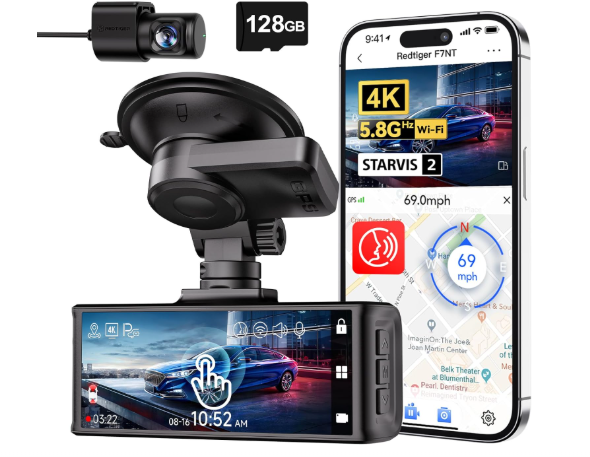
The REDTIGER F7N Touch combines premium specifications with thoughtful design elements.
Key Specifications:
- Front camera: 4K resolution with STARVIS 2 sensor
- Rear camera: Full HD resolution
- 3.18″ touch screen
- Voice control capability
- 5.8GHz WiFi connectivity
- GPS functionality
- Enhanced night vision
- Emergency recording lock
- Parking mode
- 128GB memory card included
- Operating temperature: -10°C to 65°C (14°F to 149°F)
Performance Analysis
The REDTIGER F7N Touch delivers impressive video quality with its 4K front camera and STARVIS 2 sensor. Daytime footage shows excellent detail with natural color reproduction and minimal compression artifacts.
The STARVIS 2 sensor significantly enhances night performance, producing usable footage even on poorly lit roads. Headlight flare remains controlled without overwhelming the entire frame – a common problem in lesser cameras.
The rear camera, while limited to 1080p, benefits from quality optics and good processing, resulting in clear footage that serves its purpose effectively.
GPS functionality works reliably, embedding accurate location and speed data into recordings. The implementation allows for map-based playback within the companion app, showing your precise route alongside the video.
The unique 5.8GHz WiFi implementation (slightly higher frequency than the typical 5GHz) appears to reduce interference from other devices, resulting in generally stable connections.
User Experience
The 3.18″ touch screen provides adequate space for comfortable operation. Touch response proves consistently reliable with logical menu organization. Screen brightness adjusts automatically but can be manually overridden when needed.
Voice control functionality recognizes commands reliably in most conditions, though heavy accent recognition sometimes poses challenges. The command set covers essential functions without becoming overly complex.
The companion app offers comprehensive control and easy file management. Video downloading works efficiently, and basic editing tools allow trimming clips before sharing – a thoughtful addition not found in all competitor apps.
The included 128GB memory card provides substantial value, offering approximately 8-10 hours of driving footage at maximum quality settings before loop recording activates.
Installation follows standard procedures with included adhesive mounts and cable management clips. The rear camera connection uses a single cable with appropriate length for most vehicle sizes.
Drawbacks
The camera body size runs slightly larger than some competitors, potentially limiting placement options in vehicles with restricted windshield space.
The touch screen, while functional, collects fingerprints noticeably during regular use, occasionally affecting visibility in direct sunlight.
The parking mode, while present, lacks some advanced options found in premium competitors like time-lapse recording or variable sensitivity settings.
Comprehensive Comparison: Finding Your Ideal Match
After thorough testing of all five models, clear differences emerge that might guide your selection based on specific priorities:
Best Overall Image Quality: VIOFO A229 Plus
The consistent 1440p resolution from both cameras combined with dual STARVIS 2 sensors and excellent HDR implementation delivers the most balanced image quality across all lighting conditions.
Best Value Proposition: ROVE R2-4K DUAL
The combination of 4K front recording, included 128GB card, excellent app experience, and reasonable price point makes this the most compelling complete package for most users.
Most Innovative Features: Vantrue E360
The panoramic recording capability and LTE connectivity options represent the cutting edge of dash cam technology, though at a premium price.
Best Budget Option: 4K Dual Channel Dash Cam
Despite some compromises, this unnamed brand delivers acceptable performance at a significantly lower price point, making it suitable for cost-conscious buyers.
Best User Interface: REDTIGER F7N Touch
The combination of responsive touch screen, voice control, and well-designed companion app creates the most intuitive user experience among tested models.
Installation Tips for Dual-Channel Dash Cams
Proper installation significantly impacts both performance and aesthetics:
- Plan cable routing before installation – Map the path from power source to camera location before applying adhesive mounts.
- Clean mounting surfaces thoroughly – Use alcohol wipes to remove oils and residue for secure attachment.
- Consider professional hardwiring – For parking mode functionality, professional installation of a hardwiring kit prevents battery drainage.
- Position for optimal coverage – Mount front cameras centered high on the windshield without obstructing driver vision.
- Test before finalizing – Verify angle and coverage before permanent mounting.
- Secure cables properly – Use included clips or automotive trim tools to tuck cables neatly into headliners and trim pieces.
- Format memory cards in-camera – Always format new cards using the camera’s menu system rather than a computer.
Privacy and Legal Considerations
Dash cam usage involves important legal and ethical considerations:
- Audio recording laws vary by location. Many jurisdictions require informing passengers about audio recording.
- Windshield mounting regulations differ between states and countries. Some prohibit devices that obstruct driver vision.
- Data ownership questions arise when capturing footage of others. Consider the ethics of sharing recordings online without permission.
- Evidence admissibility varies between insurance companies and legal jurisdictions. Verify local regulations regarding dash cam footage as evidence.
Final Verdict: Which Dual-Channel Dash Cam Reigns Supreme?
After extensive testing and comparison, the ROVE R2-4K DUAL emerges as the best overall option for most drivers. Its combination of excellent image quality, user-friendly operation, included accessories, and reasonable price point creates compelling value.
For drivers prioritizing absolute image quality above all else, the VIOFO A229 Plus delivers the most consistent footage across varying conditions.
Those seeking cutting-edge innovation will appreciate the Vantrue E360’s panoramic approach, while budget-conscious shoppers can find acceptable performance in the unnamed 4K dual-channel model.
The REDTIGER F7N Touch presents a strong alternative to the ROVE with slightly different feature prioritization and equally good core performance.
Ultimately, any of these models will significantly enhance your driving security compared to having no video protection. The right choice depends on your specific priorities and budget constraints.
FAQ: Common Questions About Dual-Channel Dash Cams
Q: How long do dash cams typically record before overwriting old footage? A: This depends on resolution settings and memory card size. At maximum quality, a 128GB card typically stores 8-10 hours of footage before loop recording begins.
Q: Do dash cams drain car batteries when parked? A: Without proper installation, parking mode can drain vehicle batteries. Hardwiring kits with voltage cutoff protection prevent excessive drainage.
Q: Can dash cams reduce insurance premiums? A: Some insurance companies offer discounts for dash cam usage, though policies vary. Check with your provider about potential savings.
Q: Are dash cams legal in all states? A: While dash cams themselves are legal nationwide, mounting position regulations vary by state. Some prohibit windshield mounting entirely.
Q: How often should dash cam memory cards be replaced? A: Most manufacturers recommend replacing microSD cards annually due to the wear caused by constant write cycles.
Q: Can dash cams function in extreme temperatures? A: Quality models include operating temperature ranges. Most premium options function from approximately -10°C to 65°C (14°F to 149°F).
Q: Do dash cams record when the car is turned off? A: This requires parking mode functionality, typically enabled through hardwiring to a constant power source with voltage protection.
The dash cam market continues evolving rapidly with new features and improved performance each year. Any of these five recommended models will provide reliable protection and peace of mind during your daily drives.
